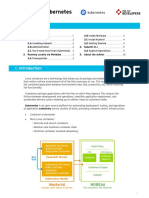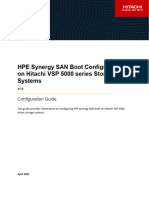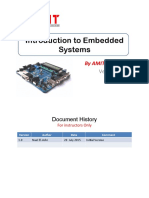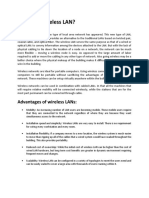Kubernetes Guide_ Architecture and Commands
Uploaded by
Sai CharanKubernetes Guide_ Architecture and Commands
Uploaded by
Sai CharanKubernetes Guide: Architecture and Commands
1. Kubernetes Architecture Overview
Kubernetes is a container orchestration platform that automates deployment,
scaling, and operations of application containers. It consists of the following key
components:
Control Plane Components:
API Server: Frontend of the cluster that handles RESTful API requests.
etcd: Distributed key-value store for configuration and state data.
Controller Manager: Ensures cluster state matches the desired state.
Scheduler: Assigns workloads (pods) to nodes.
Node Components:
Kubelet: Manages individual node and communicates with API Server.
Kube Proxy: Manages networking and enforces cluster policies.
Container Runtime: Runs containers (e.g., Docker, containerd).
2. Basic Kubernetes Commands
Cluster Management Commands:
kubectl cluster-info # Display cluster information
kubectl get nodes # List all nodes in the cluster
kubectl describe node <node-name> # Get detailed node information
kubectl drain <node-name> # Safely remove a node from service
kubectl delete node <node-name> # Delete a node
3. Pod Management Commands
kubectl get pods # List all pods
kubectl describe pod <pod-name> # Get detailed pod information
kubectl delete pod <pod-name> # Delete a pod
kubectl logs <pod-name> # View logs of a pod
kubectl exec -it <pod-name> -- /bin/sh # Access pod shell
4. Deployments and Scaling
kubectl create deployment <name> --image=<image-name> # Create a
deployment
kubectl get deployments # List deployments
kubectl scale deployment <name> --replicas=3 # Scale deployment
kubectl delete deployment <name> # Delete deployment
5. Service Management
kubectl expose deployment <name> --type=NodePort --port=80 # Create a
service
kubectl get services # List all services
kubectl describe service <service-name> # Get service details
kubectl delete service <service-name> # Delete service
6. Namespace and Context Management
kubectl get namespaces # List all namespaces
kubectl create namespace <namespace-name> # Create a namespace
kubectl delete namespace <namespace-name> # Delete a namespace
kubectl config set-context --current --namespace=<namespace-name> # Set
default namespace
7. ConfigMaps and Secrets
kubectl create configmap <config-name> --from-literal=key=value # Create a
ConfigMap
kubectl get configmaps # List ConfigMaps
kubectl describe configmap <config-name> # View details of ConfigMap
kubectl delete configmap <config-name> # Delete ConfigMap
kubectl create secret generic <secret-name> --from-literal=username=admin #
Create a secret
kubectl get secrets # List secrets
kubectl describe secret <secret-name> # View secret details
kubectl delete secret <secret-name> # Delete secret
8. Ingress and Networking
kubectl get ingress # List Ingress resources
kubectl describe ingress <ingress-name> # View Ingress details
kubectl delete ingress <ingress-name> # Delete Ingress resource
9. Storage Management
kubectl get pv # List Persistent Volumes
kubectl get pvc # List Persistent Volume Claims
kubectl delete pvc <pvc-name> # Delete a Persistent Volume Claim
10. Role-Based Access Control (RBAC)
kubectl create role <role-name> --verb=get --resource=pods # Create a role
kubectl get roles # List roles
kubectl create rolebinding <binding-name> --role=<role-name> --user=
<username> # Assign a role
kubectl get rolebindings # List role bindings
11. Troubleshooting and Debugging
kubectl get events # Get recent events in the cluster
kubectl describe pod <pod-name> # View pod details
kubectl logs <pod-name> # Fetch logs from a pod
kubectl exec -it <pod-name> -- /bin/sh # Open shell into a pod
12. Monitoring and Logging
kubectl top pod # View resource usage of pods
kubectl top node # View resource usage of nodes
13. Helm (Kubernetes Package Manager)
helm repo add stable https://charts.helm.sh/stable # Add Helm repository
helm install <release-name> stable/<chart-name> # Install a Helm chart
helm list # List all installed Helm releases
helm delete <release-name> # Uninstall a Helm release
14. Autoscaling in Kubernetes
kubectl autoscale deployment <name> --min=2 --max=5 --cpu-percent=80 #
Enable autoscaling
kubectl get hpa # List Horizontal Pod Autoscalers
kubectl delete hpa <hpa-name> # Delete an HPA
Conclusion
This guide provides a comprehensive overview of Kubernetes architecture and
essential commands needed for managing clusters, workloads, networking,
storage, security, and troubleshooting. Mastering these commands will help you
efficiently work with Kubernetes and automate your containerized applications.
Keep exploring and happy learning!
@CreatedBY:RUTIK NIKAM
You might also like
- System Design - Sequencer - Grokking Modern System Design Interview For Engineers & Managers33% (6)System Design - Sequencer - Grokking Modern System Design Interview For Engineers & Managers1 page
- 1.0.6 Class Activity - Top Hacker Shows Us How It Is Done100% (1)1.0.6 Class Activity - Top Hacker Shows Us How It Is Done2 pages
- Linuxacademy Kubernetes Studyguide 147336144350% (2)Linuxacademy Kubernetes Studyguide 147336144310 pages
- H00002007-HexagonMI-RDS User Manual-V5.4.1.202 en100% (1)H00002007-HexagonMI-RDS User Manual-V5.4.1.202 en216 pages
- Kubernetes in An Open Source Container Management Tool Hosted by Cloud Native Computing FoundationNo ratings yetKubernetes in An Open Source Container Management Tool Hosted by Cloud Native Computing Foundation8 pages
- How to Install Kubernetes Cluster on Ubuntu 24.04 LTS (Step-by-Step Guide)No ratings yetHow to Install Kubernetes Cluster on Ubuntu 24.04 LTS (Step-by-Step Guide)4 pages
- Multinode Kubernetes Cluster 190213174918No ratings yetMultinode Kubernetes Cluster 19021317491846 pages
- Kubernates Kubectl Context and Configuration: Authenticating Across Clusters With KubeconfigNo ratings yetKubernates Kubectl Context and Configuration: Authenticating Across Clusters With Kubeconfig9 pages
- How To Install Kubernetes Cluster On Ubuntu 22.04 (Step-by-Step Guide) - by Hakan Bayraktar - MediumNo ratings yetHow To Install Kubernetes Cluster On Ubuntu 22.04 (Step-by-Step Guide) - by Hakan Bayraktar - Medium16 pages
- Kubernetes Cheatsheet Kubectl Quick ReferenceNo ratings yetKubernetes Cheatsheet Kubectl Quick Reference10 pages
- Kubernetes-Personal Notes-Naresh Kumar ChityalaNo ratings yetKubernetes-Personal Notes-Naresh Kumar Chityala9 pages
- Kubernetes Tasks Documentation: Release 0.1No ratings yetKubernetes Tasks Documentation: Release 0.151 pages
- What Is TLS Bootstrapping?: The Following Steps Were InvolvedNo ratings yetWhat Is TLS Bootstrapping?: The Following Steps Were Involved3 pages
- Follow The "Installing Kubernetes On Linux With Kubeadm" Guide On The Catalyst CloudNo ratings yetFollow The "Installing Kubernetes On Linux With Kubeadm" Guide On The Catalyst Cloud8 pages
- Hands-On Multi-Cloud Kubernetes: Multi-cluster kubernetes deployment and scaling with FluxCD, Virtual Kubelet, Submariner and KubeFedFrom EverandHands-On Multi-Cloud Kubernetes: Multi-cluster kubernetes deployment and scaling with FluxCD, Virtual Kubelet, Submariner and KubeFedNo ratings yet
- Power Apps - Interview Preparation Guide - v1No ratings yetPower Apps - Interview Preparation Guide - v124 pages
- For More Study Books Join Here: Https://t.me/pdfbasketNo ratings yetFor More Study Books Join Here: Https://t.me/pdfbasket58 pages
- For More Study Books Join Here: Https://t.me/pdfbasketNo ratings yetFor More Study Books Join Here: Https://t.me/pdfbasket58 pages
- Subject Code: Asc 372 Subject Title: Heat TransferNo ratings yetSubject Code: Asc 372 Subject Title: Heat Transfer11 pages
- Selection of Management Trainees / Design Trainees - 2021 AANo ratings yetSelection of Management Trainees / Design Trainees - 2021 AA6 pages
- Extra Ignition Materials - Inductive AutomationNo ratings yetExtra Ignition Materials - Inductive Automation5 pages
- HP Color Pro M454 MFP M479 Manual TroubleshootingNo ratings yetHP Color Pro M454 MFP M479 Manual Troubleshooting240 pages
- FSCK Error On Boot - Dev - Sda6 - UNEXPECTED INCONSISTENCY RUN FSCK MANUALLY - Ask UbuntuNo ratings yetFSCK Error On Boot - Dev - Sda6 - UNEXPECTED INCONSISTENCY RUN FSCK MANUALLY - Ask Ubuntu6 pages
- (MMU) Software Varification and Validation - Lecture 2No ratings yet(MMU) Software Varification and Validation - Lecture 218 pages
- Hitachi Virtual Storage Platform 5000 Series Storage and HPE Synergy Configuration For SAN BootNo ratings yetHitachi Virtual Storage Platform 5000 Series Storage and HPE Synergy Configuration For SAN Boot41 pages
- 38.self & - Init - (Constructors) PythonNo ratings yet38.self & - Init - (Constructors) Python4 pages
- Lesson 10: Integrated Circuits: ELECTRONICS CLASS (/class/Electronics-Class/)No ratings yetLesson 10: Integrated Circuits: ELECTRONICS CLASS (/class/Electronics-Class/)9 pages
- What Is A Wireless Lan?: Advantages of Wireless LansNo ratings yetWhat Is A Wireless Lan?: Advantages of Wireless Lans4 pages
- System Design - Sequencer - Grokking Modern System Design Interview For Engineers & ManagersSystem Design - Sequencer - Grokking Modern System Design Interview For Engineers & Managers
- 1.0.6 Class Activity - Top Hacker Shows Us How It Is Done1.0.6 Class Activity - Top Hacker Shows Us How It Is Done
- Kubernetes in An Open Source Container Management Tool Hosted by Cloud Native Computing FoundationKubernetes in An Open Source Container Management Tool Hosted by Cloud Native Computing Foundation
- How to Install Kubernetes Cluster on Ubuntu 24.04 LTS (Step-by-Step Guide)How to Install Kubernetes Cluster on Ubuntu 24.04 LTS (Step-by-Step Guide)
- Kubernates Kubectl Context and Configuration: Authenticating Across Clusters With KubeconfigKubernates Kubectl Context and Configuration: Authenticating Across Clusters With Kubeconfig
- How To Install Kubernetes Cluster On Ubuntu 22.04 (Step-by-Step Guide) - by Hakan Bayraktar - MediumHow To Install Kubernetes Cluster On Ubuntu 22.04 (Step-by-Step Guide) - by Hakan Bayraktar - Medium
- What Is TLS Bootstrapping?: The Following Steps Were InvolvedWhat Is TLS Bootstrapping?: The Following Steps Were Involved
- Follow The "Installing Kubernetes On Linux With Kubeadm" Guide On The Catalyst CloudFollow The "Installing Kubernetes On Linux With Kubeadm" Guide On The Catalyst Cloud
- Hands-On Multi-Cloud Kubernetes: Multi-cluster kubernetes deployment and scaling with FluxCD, Virtual Kubelet, Submariner and KubeFedFrom EverandHands-On Multi-Cloud Kubernetes: Multi-cluster kubernetes deployment and scaling with FluxCD, Virtual Kubelet, Submariner and KubeFed
- Mastering Kubernetes: From Basics to Expert ProficiencyFrom EverandMastering Kubernetes: From Basics to Expert Proficiency
- For More Study Books Join Here: Https://t.me/pdfbasketFor More Study Books Join Here: Https://t.me/pdfbasket
- For More Study Books Join Here: Https://t.me/pdfbasketFor More Study Books Join Here: Https://t.me/pdfbasket
- Subject Code: Asc 372 Subject Title: Heat TransferSubject Code: Asc 372 Subject Title: Heat Transfer
- Selection of Management Trainees / Design Trainees - 2021 AASelection of Management Trainees / Design Trainees - 2021 AA
- FSCK Error On Boot - Dev - Sda6 - UNEXPECTED INCONSISTENCY RUN FSCK MANUALLY - Ask UbuntuFSCK Error On Boot - Dev - Sda6 - UNEXPECTED INCONSISTENCY RUN FSCK MANUALLY - Ask Ubuntu
- (MMU) Software Varification and Validation - Lecture 2(MMU) Software Varification and Validation - Lecture 2
- Hitachi Virtual Storage Platform 5000 Series Storage and HPE Synergy Configuration For SAN BootHitachi Virtual Storage Platform 5000 Series Storage and HPE Synergy Configuration For SAN Boot
- Lesson 10: Integrated Circuits: ELECTRONICS CLASS (/class/Electronics-Class/)Lesson 10: Integrated Circuits: ELECTRONICS CLASS (/class/Electronics-Class/)
- What Is A Wireless Lan?: Advantages of Wireless LansWhat Is A Wireless Lan?: Advantages of Wireless Lans































































































